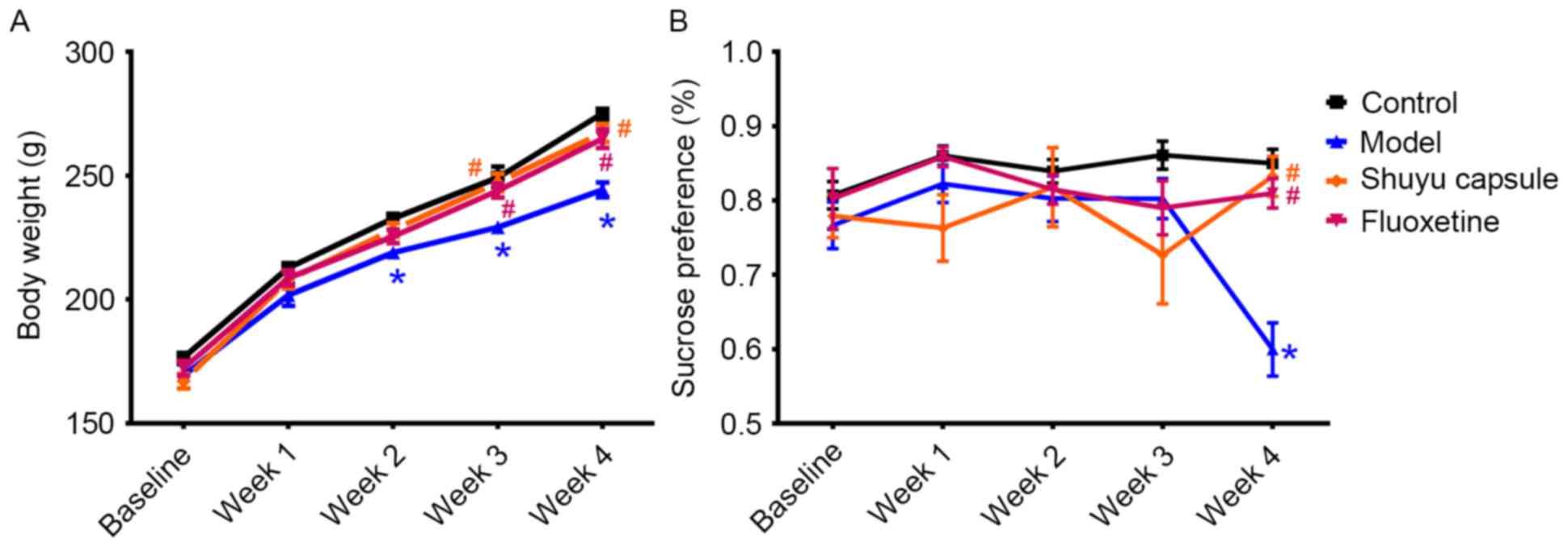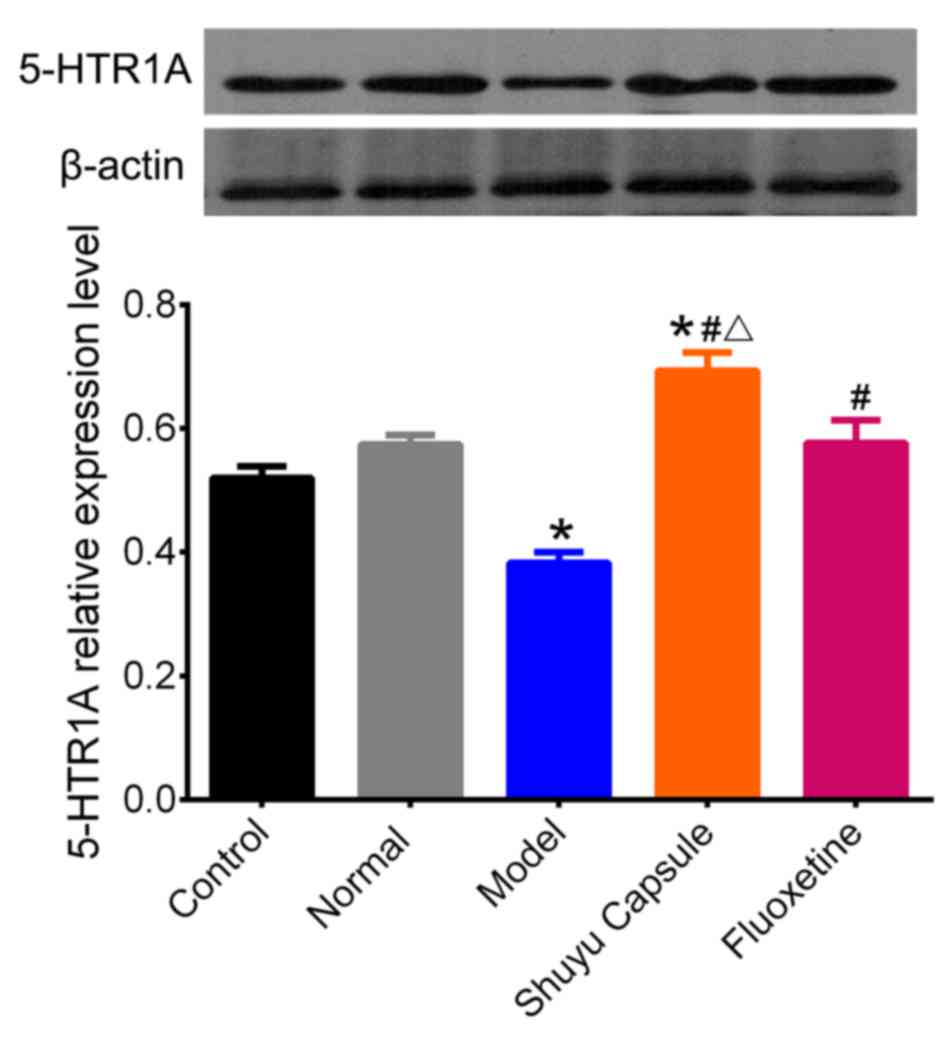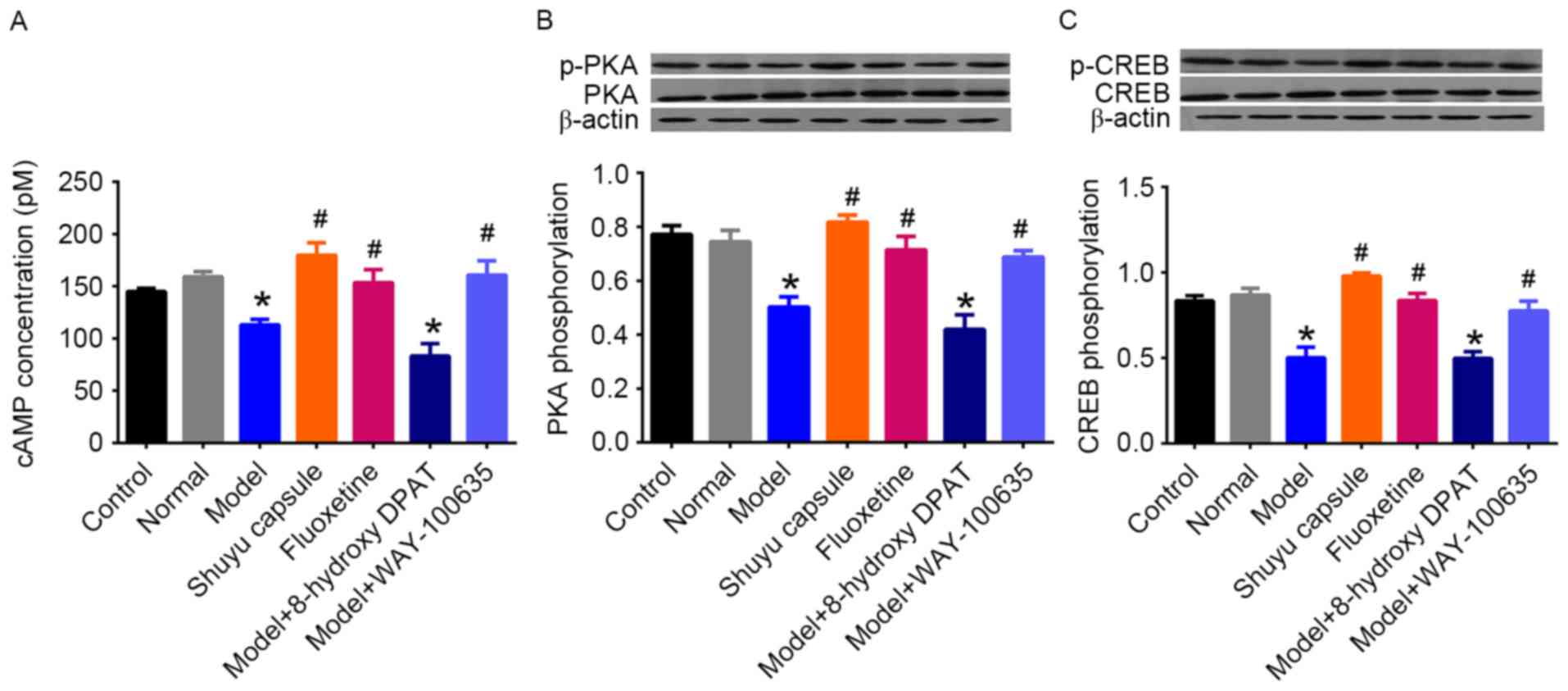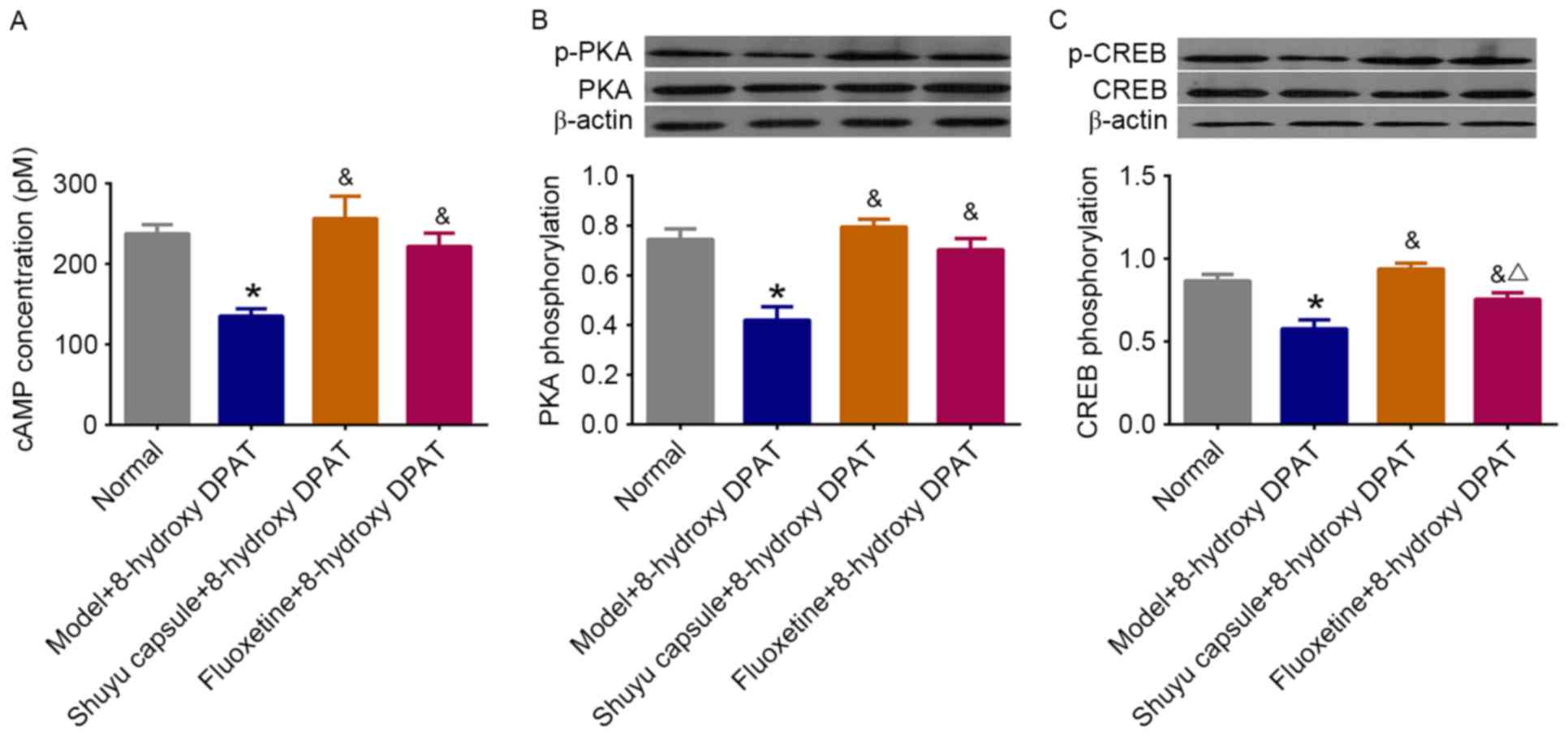|
1
|
Isometsä E: Suicidal behaviour in mood
disorders-who, when and why? Can J Psychiatry. 59:120–130. 2014.
View Article : Google Scholar : PubMed/NCBI
|
|
2
|
Song L, Che W, Min-Wei W, Murakami Y and
Matsumoto K: Impairment of the spatial learning and memory induced
by learned helplessness and chronic mild stress. Pharmacol Biochem
Behav. 83:186–193. 2006. View Article : Google Scholar : PubMed/NCBI
|
|
3
|
Delgado PL: Depression: The case for a
monoamine deficiency. J Clin Psychiatry. 61 Suppl 6:S7–S11.
2000.
|
|
4
|
Dording CM, Mischoulon D, Petersen TJ,
Kornbluh R, Gordon J, Nierenberg AA, Rosenbaum JE and Fava M: The
pharmacologic management of SSRI-induced side effects: A survey of
psychiatrists. Ann Clin Psychiatry. 14:143–147. 2002. View Article : Google Scholar : PubMed/NCBI
|
|
5
|
Fitzgerald KT and Bronstein AC: Selective
serotonin reuptake inhibitor exposure. Top Companion Anim Med.
28:13–17. 2013. View Article : Google Scholar : PubMed/NCBI
|
|
6
|
Butler L and Pilkington K: Chinese herbal
medicine and depression: The research evidence. Evid Based
Complement Alternat Med. 2013:7397162013. View Article : Google Scholar : PubMed/NCBI
|
|
7
|
Qin F, Wu XA, Tang Y, Huang Q, Zhang ZJ
and Yuan JH: Meta-analysis of randomized controlled trials to
assess the effectiveness and safety of free and easy wanderer plus,
a polyherbal preparation for depressive disorders. J Psychiatr Res.
45:1518–1524. 2011. View Article : Google Scholar : PubMed/NCBI
|
|
8
|
Zhang Y, Han M, Liu Z, Wang J, He Q and
Liu J: Chinese herbal formula xiao yao san for treatment of
depression: A systematic review of randomized controlled trials.
Evid Based Complement Alternat Med. 2012:9316362012.PubMed/NCBI
|
|
9
|
Lee B, Yun HY, Shim I, Lee H and Hahm DH:
Bupleurum falcatum prevents depression and anxiety-like behaviors
in rats exposed to repeated restraint stress. J Microbiol
Biotechnol. 22:422–430. 2012. View Article : Google Scholar : PubMed/NCBI
|
|
10
|
Qiu F, Zhong X, Mao Q and Huang Z: The
antidepressant-like effects of paeoniflorin in mouse models. Exp
Ther Med. 5:1113–1116. 2013. View Article : Google Scholar : PubMed/NCBI
|
|
11
|
Dhingra D and Sharma A:
Antidepressant-like activity of Glycyrrhiza glabra L. in mouse
models of immobility tests. Prog Neuropsychopharmacol Biol
Psychiatry. 30:449–454. 2006. View Article : Google Scholar : PubMed/NCBI
|
|
12
|
Sarris J, Panossian A, Schweitzer I,
Stough C and Scholey A: Herbal medicine for depression, anxiety and
insomnia: A review of psychopharmacology and clinical evidence. Eur
Neuropsychopharmacol. 21:841–460. 2011. View Article : Google Scholar : PubMed/NCBI
|
|
13
|
Xu K, Li Z and Gao J: Effect of Shuyu
capsule on liver-qi stagnation rat model of depressive disorder
based on the analysis of gene expression microarray technique. Chin
Pharmocol Bulletin. 30:437–438. 2014.(In Chinese).
|
|
14
|
Gordon JA and Hen R: The serotonergic
system and anxiety. Neuromolecular Med. 5:27–40. 2004. View Article : Google Scholar : PubMed/NCBI
|
|
15
|
Robinson DS, Rickels K, Feighner J, Fabre
LF Jr, Gammans RE, Shrotriya RC, Alms DR, Andary JJ and Messina ME:
Clinical effects of the 5-HT1A partial agonists in depression: A
composite analysis of buspirone in the treatment of depression. J
Clin Psychopharmacol. 10:67S–76S. 1990. View Article : Google Scholar : PubMed/NCBI
|
|
16
|
Wong DT, Bymaster FP and Engleman EA:
Prozac (fluoxetine, Lilly 110140), the first selective serotonin
uptake inhibitor and an antidepressant drug: Twenty years since its
first publication. Life Sci. 57:411–441. 1995. View Article : Google Scholar : PubMed/NCBI
|
|
17
|
Riad M, Zimmer L, Rbah L, Watkins KC,
Hamon M and Descarries L: Acute treatment with the antidepressant
fluoxetine internalizes 5-HT1A autoreceptors and reduces the in
vivo binding of the PET radioligand [18F]MPPF in the nucleus raphe
dorsalis of rat. J Neurosci. 24:5420–4526. 2004. View Article : Google Scholar : PubMed/NCBI
|
|
18
|
Drevets WC, Thase ME, Moses-Kolko EL,
Price J, Frank E, Kupfer DJ and Mathis C: Serotonin-1A receptor
imaging in recurrent depression: Replication and literature review.
Nucl Med Biol. 34:865–877. 2007. View Article : Google Scholar : PubMed/NCBI
|
|
19
|
Savitz J, Lucki I and Drevets WC: 5-HT(1A)
receptor function in major depressive disorder. Prog Neurobiol.
88:17–31. 2009. View Article : Google Scholar : PubMed/NCBI
|
|
20
|
Birnbaumer L: Expansion of signal
transduction by G proteins. The second 15 years or so: From 3 to 16
alpha subunits plus betagamma dimers. Biochim Biophys Acta.
1768:772–793. 2007. View Article : Google Scholar : PubMed/NCBI
|
|
21
|
Pucadyil TJ, Kalipatnapu S and
Chattopadhyay A: The serotonin1A receptor: A representative member
of the serotonin receptor family. Cell Mol Neurobiol. 25:553–580.
2005. View Article : Google Scholar : PubMed/NCBI
|
|
22
|
Ohno Y: New insight into the therapeutic
role of 5-HT1A receptors in central nervous system disorders. Cent
Nerv Syst Agents Med Chem. 10:148–157. 2010. View Article : Google Scholar : PubMed/NCBI
|
|
23
|
Kim MH and Leem YH: Chronic exercise
improves repeated restraint stress-induced anxiety and depression
through 5HT1A receptor and cAMP signaling in hippocampus. J Exerc
Nutrition Biochem. 18:97–104. 2014. View Article : Google Scholar : PubMed/NCBI
|
|
24
|
Wang C, Guo J and Guo R: Effect of
XingPiJieYu decoction on spatial learning and memory and
cAMP-PKA-CREB-BDNF pathway in rat model of depression through
chronic unpredictable stress. BMC Complement Altern Med. 17:732017.
View Article : Google Scholar : PubMed/NCBI
|
|
25
|
Thome J, Henn FA and Duman RS: Cyclic AMP
response element-binding protein and depression. Expert Rev
Neurother. 2:347–354. 2002. View Article : Google Scholar : PubMed/NCBI
|
|
26
|
Wang FR, Qiao MQ, Xue L and Wei S:
Possible involvement of µ opioid receptor in the
antidepressant-like effect of shuyu formula in restraint
stress-induced depression-like rats. Evid Based Complement Alternat
Med. 2015:4524122015.PubMed/NCBI
|
|
27
|
Willner P, Towell A, Sampson D,
Sophokleous S and Muscat R: Reduction of sucrose preference by
chronic unpredictable mild stress, and its restoration by a
tricyclic antidepressant. Psychopharmacology (Berl). 93:358–364.
1987. View Article : Google Scholar : PubMed/NCBI
|
|
28
|
Nunez J: Primary culture of hippocampal
neurons from P0 newborn rats. J Vis Exp. 19:pii: 8952008.
|
|
29
|
Gaillard R, Gourion D and Llorca PM:
Anhedonia in depression. Encephale. 39:296–305. 2013. View Article : Google Scholar : PubMed/NCBI
|
|
30
|
Overstreet DH: Modeling depression in
animal models. Methods Mol Biol. 829:125–144. 2012. View Article : Google Scholar : PubMed/NCBI
|
|
31
|
Willner P: Validity, reliability and
utility of the chronic mild stress model of depression: A 10-year
review and evaluation. Psychopharmacology (Berl). 134:319–329.
1997. View Article : Google Scholar : PubMed/NCBI
|
|
32
|
Muscat R and Willner P: Suppression of
sucrose drinking by chronic mild unpredictable stress: A
methodological analysis. Neurosci Biobehav Rev. 16:507–517. 1992.
View Article : Google Scholar : PubMed/NCBI
|
|
33
|
Bessa JM, Ferreira D, Melo I, Marques F,
Cerqueira JJ, Palha JA, Almeida OF and Sousa N: The mood-improving
actions of antidepressants do not depend on neurogenesis but are
associated with neuronal remodeling. Mol Psychiatry. 14:764–773.
2009.39. View Article : Google Scholar : PubMed/NCBI
|
|
34
|
Leach G, Adidharma W and Yan L:
Depression-like responses induced by daytime light deficiency in
the diurnal grass rat (Arvicanthis niloticus). PLoS One.
8:e571152013. View Article : Google Scholar : PubMed/NCBI
|
|
35
|
Yu J, Liu Q, Wang YQ, Wang J, Li XY, Cao
XD and Wu GC: Electroacupuncture combined with clomipramine
enhances antidepressant effect in rodents. Neurosci Lett. 421:5–9.
2007. View Article : Google Scholar : PubMed/NCBI
|
|
36
|
Wu X, Alberico SL, Moges H, De Taboada L,
Tedford CE and Anders JJ: Pulsed light irradiation improves
behavioral outcome in a rat model of chronic mild stress. Lasers
Surg Med. 44:227–232. 2012. View Article : Google Scholar : PubMed/NCBI
|
|
37
|
Iwama H, Amagaya S and Ogihara Y: Effect
of shosaikoto, a Japanese and Chinese traditional herbal medicinal
mixture, on the mitogenic activity of lipopolysaccharide: A new
pharmacological testing method. J Ethnopharmacol. 21:45–53. 1987.
View Article : Google Scholar : PubMed/NCBI
|
|
38
|
Li F, Zhang YB, Wei X, Song CH, Qiao MQ
and Zhang HY: Metabolic profiling of Shu-Yu capsule in rat serum
based on metabolic fingerprinting analysis using HPLC-ESI-MSn. Mol
Med Rep. 13:4191–4204. 2016. View Article : Google Scholar : PubMed/NCBI
|
|
39
|
Stahl S: 5HT1A receptors and
pharmacotherapy. Is serotonin receptor down-regulation linked to
the mechanism of action of antidepressant drugs? Psychopharmacol
Bull. 30:39–43. 1994.PubMed/NCBI
|
|
40
|
Larsson LG, Stenfors C and Ross SB:
Differential regional antagonism of 8-OH-DPAT-induced decrease in
serotonin synthesis by two 5-HT1A receptor antagonists. Eur J
Pharmacol. 346:209–215. 1998. View Article : Google Scholar : PubMed/NCBI
|
|
41
|
De Vry J, Schreiber R, Melon C, Dalmus M
and Jentzsch KR: 5-HT1A receptors are differentially involved in
the anxiolytic- and antidepressant-like effects of 8-OH-DPAT and
fluoxetine in the rat. Eur Neuropsychopharmacol. 14:487–495. 2004.
View Article : Google Scholar : PubMed/NCBI
|
|
42
|
Shishkina GT, Kalinina TS and Dygalo NN:
Effects of swim stress and fluoxetine on 5-HT1A receptor gene
expression and monoamine metabolism in the rat brain regions. Cell
Mol Neurobiol. 32:787–794. 2012. View Article : Google Scholar : PubMed/NCBI
|
|
43
|
Dowlatshahi D, MacQueen GM, Wang JF,
Reiach JS and Young LT: G Protein-coupled cyclic AMP signaling in
postmortem brain of subjects with mood disorders: Effects of
diagnosis, suicide, and treatment at the time of death. J
Neurochem. 73:1121–1126. 1999. View Article : Google Scholar : PubMed/NCBI
|
|
44
|
Shelton RC, Mainer DH and Sulser F:
cAMP-dependent protein kinase activity in major depression. Am J
Psychiatry. 153:1037–10342. 1996. View Article : Google Scholar : PubMed/NCBI
|
|
45
|
Li YC, Wang FM, Pan Y, Qiang LQ, Cheng G,
Zhang WY and Kong LD: Antidepressant-like effects of curcumin on
serotonergic receptor-coupled AC-cAMP pathway in chronic
unpredictable mild stress of rats. Prog Neuropsychopharmacol Biol
Psychiatry. 33:435–449. 2009. View Article : Google Scholar : PubMed/NCBI
|
|
46
|
Hsiung SC, Tin A, Tamir H, Franke TF and
Liu KP: Inhibition of 5-HT1A receptor-dependent cell survival by
cAMP/protein kinase A: Role of protein phosphatase 2A and Bax. J
Neurosci Res. 86:2326–2338. 2008. View Article : Google Scholar : PubMed/NCBI
|
|
47
|
Duman RS, Malberg J, Nakagawa S and D'Sa
C: Neuronal plasticity and survival in mood disorders. Biol
Psychiatry. 48:732–739. 2000. View Article : Google Scholar : PubMed/NCBI
|
|
48
|
Shaywitz AJ and Greenberg ME: CREB: A
stimulus-induced transcription factor activated by a diverse array
of extracellular signals. Annu Rev Biochem. 68:821–861. 1999.
View Article : Google Scholar : PubMed/NCBI
|
|
49
|
Tiraboschi E, Tardito D, Kasahara J,
Moraschi S, Pruneri P, Gennarelli M, Racagni G and Popoli M:
Selective phosphorylation of nuclear CREB by fluoxetine is linked
to activation of CaM kinase IV and MAP kinase cascades.
Neuropsychopharmacology. 29:1831–1840. 2004. View Article : Google Scholar : PubMed/NCBI
|
|
50
|
Duman CH, Schlesinger L, Kodama M, Russell
DS and Duman RS: A role for MAP kinase signaling in behavioral
models of depression and antidepressant treatment. Biol Psychiatry.
61:661–670. 2007. View Article : Google Scholar : PubMed/NCBI
|
|
51
|
Seth P, Gajendiran M and Ganguly DK:
Desensitization of spinal 5-HT1A receptors to 8-OH-DPAT: An in vivo
spinal reflex study. Neuroreport. 8:2489–2493. 1997. View Article : Google Scholar : PubMed/NCBI
|
|
52
|
Fletcher A, Forster EA, Bill DJ, Brown G,
Cliffe IA, Hartley JE, Jones DE, McLenachan A, Stanhope KJ,
Critchley DJ, et al: Electrophysiological, biochemical,
neurohormonal and behavioural studies with WAY-100635, a potent,
selective and silent 5-HT1A receptor antagonist. Behav Brain Res.
73:337–353. 1996. View Article : Google Scholar : PubMed/NCBI
|













